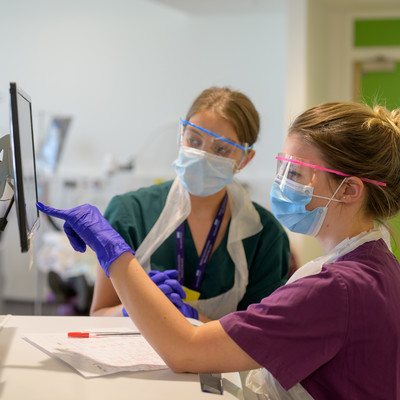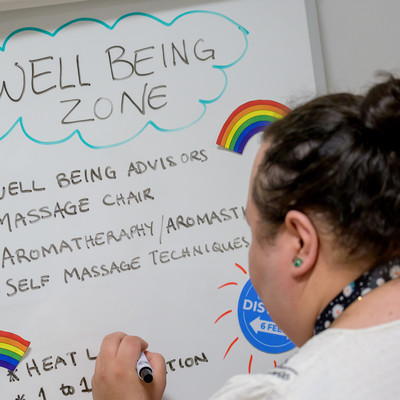

As part of our campaign to deliver #FairFlexibleFutures for people in everyday jobs, we’ve been exploring how organisations have learned from, and responded to, the pandemic. Here, we share insights from an NHS Foundation Trust.
Guy’s and St Thomas’ is an NHS Foundation Trust that runs Guy’s Hospital in London Bridge, St Thomas’ Hospital in Waterloo, Evelina London Children’s Hospital, Royal Brompton and Harefield Hospitals and community services in Lambeth and Southwark. The Trust now employs 23,000 people.

As director of workforce programmes, Lynn Demeda runs several strategic workforce initiatives at Guy’s and St Thomas’. Lynn is currently working on partnerships with other hospitals including the recent merger of Royal Brompton and Harefield Hospitals. This merger has resulted in the transfer of 4000 staff into the employment of Guy’s and St Thomas in February 2021.
Life before lockdown
Before lockdown, Guy’s and St Thomas’ had well founded policies with around 20% of staff working part-time and 57% of staff indicating they felt satisfied with flexible working support. The greatest barrier to more flexibility was mindset; some managers had their reservations around productivity, performance management and being able to sustain service delivery. Lynn and her team therefore worked to encourage open conversations about working differently and exploring options to support individual needs.
Corporate staff in office roles could work anywhere in both formal and informal arrangements with flexible hours and remote desktops. However, for those working on the front-line in patient facing roles, implementing flexible working was more challenging. As remote working was often not possible, team-based approaches to shift hours were crucial; it enabled some teams team to create a rota that considered both individual and service needs.
A concrete example of this was in the paediatric intensive care department. As a specialist role, paediatrics are often difficult to recruit and retain. The lead nurse had open conversations within the team about what hours staff wanted to work. A self-rostering approach was then adopted, giving the team more flexibility in their hours and the ability to swap with their colleagues.
Reacting to the crisis
When lockdown was announced, the Trust reduced several services such as elective surgery and dental services to focus on supporting Covid-19 patients. This meant staff could be redeployed into high demand areas. While redeployment was done based on demand, it meant staff had more flexibility to move departments and become multi-skilled; staff were trained in new skills to support them in taking on different roles.
To continue supporting patients, Guy’s and St Thomas’ introduced video and online consultations to replace most out-patient appointments. Using the secure platform ‘Attend Anywhere’, doctors could consult their patients remotely, be it the hospital or home. The teams have found this to be welcomed by patients and have seen reductions in DNA (do not attend) appointments, saving valuable time and enhancing patient experience.
Online consultations also changed how services were provided. For example, some patients who were previously treated on an individual face to face basis, moved to online group sessions in lockdown. It was well received by patients as they felt they could connect with people with similar experiences.
For those that continued to work in clinic, a blended working pattern was adopted. Roles were reviewed on a team basis to understand what needed to be done in the hospital, and what could be done at home.
These changes gave staff greater flexibility in where they worked, increasing uptake in home and remote working.
Supporting employees to keep working
Lynn and her team understood that moving from face to face delivery to a remote service was a big cultural shift that needed to be supported. A range of resources were available on how to work remotely. Seeing leaders and local-line managers as fundamental to change, Lynn’s team delivered online workshops on remote leadership. These sessions equipped managers with the knowledge to set out clear expectations; building trust in teams and focusing on output rather than hours.
Additionally, the importance of personal well-being was highlighted in corporate messaging and on site: hospitals were made Covid secure, rest and recharge areas were created, and a supermarket was opened for staff to get their essentials. Additionally, psychologists were deployed to help address some of the staff’s experiences whether on site or working from home.
Learning from the experience
Covid-19 has accelerated Guy’s and St Thomas’ progression in new ways of working, supported by digital transformation. The majority of outpatient appointments are now done virtually, with only critical sessions being delivered face to face. This process has allowed employees to rethink where and how they work; roles that previously had to be onsite can now be done remotely.
For Lynn, one of the biggest learnings is the need for team-based decision making. The pandemic forced managers to make quick decisions on a local line basis. Involving staff in these processes helps to find sustainable solutions that met team, individual and service delivery needs.
Lastly, prioritising employee well-being has highlighted the importance of flexible working. This has been two-fold; Guy’s and St Thomas’ offered staff flexibility to support work life balance, but staff had to be flexible in their roles to meet Covid-19 demand. Staff have acquired new skills and cross-functional working has helped foster a close community. Line managers now have frequent conversations and check ins with staff, proactively encouraging open discussions around well-being and work-life balance. Lockdown has normalised these conversations and adjusted the focus from hours to output.

As a clinical nurse specialist on the Integrated Respiratory Team, Ellie Linacre supports inpatients with COPD asthma or those who require home oxygen. Ellie also does community work, working with COPD patients and conducting home visits.
Life before lockdown
Before Covid-19, Ellie worked a five-day week: four days supporting inpatients and the other day doing community work. Ellie had the flexibility to change her community days as and when inpatient case load needed.
Working 8:45-4:45pm and often on weekends, Ellie and the team covered the respiratory service every day of the year. This meant working seven days in a row over the weekend, followed by two days off. This working pattern did make work-life balance challenging.
Working through the crisis
Almost overnight, Ellie’s team of physiotherapists and respiratory nurses was reduced to five members as the others were redeployed to intensive care. As most of Ellie’s work is based in the hospital working with patients, Ellie was unable to work from home.
Wanting to provide the same level of service to their patients, Ellie and her team quickly decided to work 9.5-hour days. Their shift pattern changed to four days to account for the long hours. Working through Covid-19 peaks was exhausting so the flexibility to change their shift pattern helped avoid exhaustion.
Using a team-based approach, the team submitted their shift requests to Ellie who then built the rota. Ellie divided the weekend hours equally making sure there was always two people on shift. Those with child caring responsibilities were prioritised. The process was fair and amongst all the chaos the rota offered stability in being one of the few things Ellie could control.
Support from employers
Leadership were very supportive and delighted that the team wanted to deliver the same level of patient care through lockdown. There was the right balance in having access to guidance and resources and being trusted to make decisions at a team level.
The core team also had a Whatsapp group to keep everyone updated and in touch. Whether it be providing updates on patients or Ellie sending pictures of her pet tortoise, the group became a space for team interaction.
Additionally, the team would have weekly meetings with those that had been redeployed. This meant when they returned to the department, they were up to date with patient care and aware of the new pattern. Once the team was reunited, theyunanimously choose to continue working in the new pattern, collectively discussing any improvements.
Learning from the experience
Using a team-based approach has been crucial to this period. More recently the team have been allowed to self-rota. This has saved Ellie a lot of time and allowed the team to build a greater awareness of each other’s needs and preferences.
Before lockdown around 50% of the team worked later. With new shift patterns, fewer members of staff are working beyond their hours. Extending shift hours appropriately has given the team enough time to complete administrative tasks on the clock.
The freedom to explore and trial different working patterns with Guy’s and St Thomas’ support has given Ellie greater flexibility. This time has also taught Ellie to appreciate rest time, looking out for her own well-being as well as her patients.
This case study is part of a series supported by The National Lottery Community Fund, as part of their Emerging Futures Fund
Click on the links below to read the other case studies in the series: